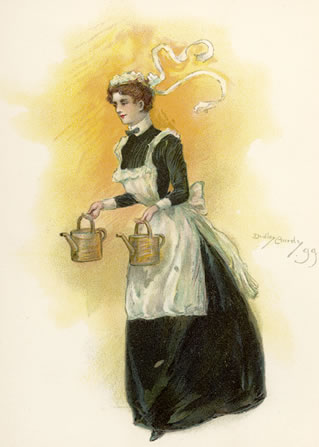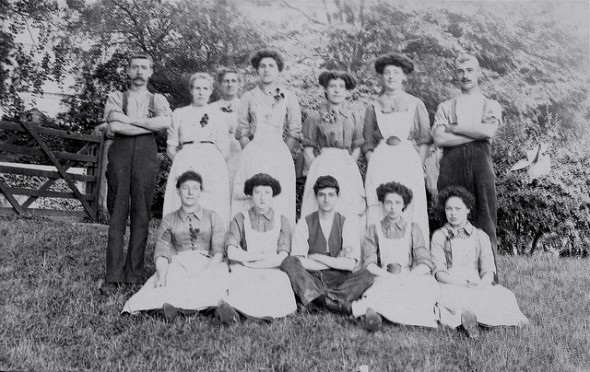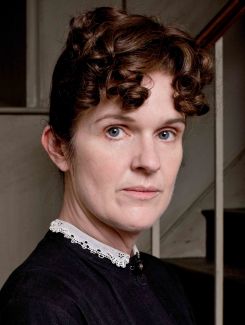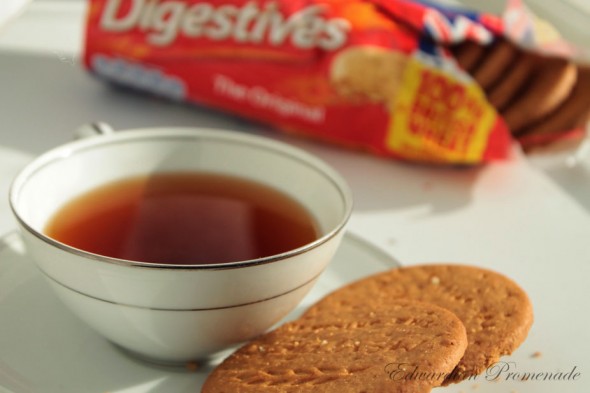
Millionaires of the Gilded Age looked to Europeans–or more specifically, the British–for cues on how to recreate the leisured life in America, copying them from the construction of country estates, to golf clubs, to social seasons, all the way down to the bottom of this lifestyle: domestic servants. Yet, save indentured servitude and slavery, American culture was built on the premise that there was no servant class.
Perhaps one reason why Americans invented and/or took to labor-saving devices with alacrity can be traced to the difficulty of hiring and retaining large numbers of domestic servants. A banker’s wife in Chicago could not expect to find cheap and willing labor like a banker’s wife in London, and so electric lights, central heating, vacuum cleaners, and up-to-date bathrooms were a must. However, immigration from the Old World provided a steady, if not completely reliable stream of would-be servants, and as testament to America’s geographical individuality, servant culture was not uniform or standard across the nation.
The first note of Americanism into the equation was the near absence of the word “servant”. Over the course of the late nineteenth century, advice columns and etiquette books wrangled over how to address the people who helped with the smooth running of one’s household, from “help” or “hand” to “staff”, to referring to a lady’s maid as “semptress” and a footman as “waiter”. William Randolph Hearst preferred to call his own maids, butler, chauffeur, etc his “staff” or “employees,” but ironically, the word “servant” was reintroduced into the homes of the wealthiest Americans by both their aggressive aping of English habits and the immigrants they employed (who were accustomed to being referred to as servants). These people, considered the very social elite, with their mansions in New York, their cottages in Newport, their 200 ft yachts, their country estates on Long Island or along the Hudson River, their camps in the Adirondacks, and their winter homes at Tuxedo Park or in the Berkshires, took the staffing of their residences to another level.
To facilitate the nouveau riche into their new setting, Mary Elizabeth Carter, a former housekeeper to the elite, published Millionaire Households and Their Domestic Economy, where she stressed:
The loud and prolonged outcry against servants as a class unquestionably is due to inefficiency of the average mistress, past and present, quite as much as to servants’ lack of training. The latter is an outcome of the former, because the ranks of housekeepers are constantly being augmented by women and girls untaught and inexperienced in the management of well-ordered homes. They know neither how to do nor how to direct the work of their houses, and are, in consequence, ignorant of what should be required as a fair day’s service from each servant.
To tackle the thorny issue of the “Servant Question”, American housewives found two solutions: improve the conditions of their servants, and lighten the burden of work. Servants quarters in an American mansion were generous and attractive, and unlike in English households, were furnished with new furniture and linens (perhaps not the exquisite items owned by the lady of the house, but new and comfortable, nonetheless). New homes, such as Clarence Mackay’s Harbor Hill on Long Island, were planned with the housing of the staff in mind.
The Mackays employed twenty-five indoor staff, and many more outdoor staff, who were housed in their own wing of bedrooms. There were also upper servants’ and lower servants’ dining halls, a butler’s den, a housekeeper’s room, and a laundry room and sewing room set aside for their personal use. The construction of the American country house also lightened the workload for the staff, and the typical English country house feature of separate rooms for separate work and the long corridors separating the kitchen from the dining room (as the English abhorred the smell of cooking emanating from the kitchen), were abolished. This change–particularly the former–placed a greater emphasis on the kitchen that remains in American architecture to this day.
Truly easing the life of household and staff were electrical appliances. The English were slow to adopt labor-saving apparatuses until the servant shortages and high wages of post-WWI, but Americans were–the words of Clarence Cook–a nation “in love with machines and contrivance.” Gas ranges eliminated the arduous and dirty work of laying a fire in the old coal-burning ranges and the expense of coal, and they didn’t have to be lit all day. With electricity came the toaster, the vacuum cleaner, the coffee percolator, and the electric fan, all of which–including the telephone–were considered the “New Answer to the Servant Problem”.
The other issue plaguing upper class Americans was whom to hire. American racial prejudices and the differing waves of immigration played a part in just who you might find working in the kitchens of a city mansion or country estate. In the South, the long history of slavery held firm in the ethnic make-up of domestic staff, though the migration of Northerners to vacation spots in Florida or Georgia, or to Washington D.C., and the increasingly negative race relations of the 1900s, influenced the decline in African-American upper servants. Irish immigrants made up the majority of domestic staff in cities like New York, Boston, or Philadelphia, but they were considered “dirty” and “lazy”, and many mistresses didn’t bother learning their names, instead calling all Irish housemaids “Bridgets” or “Biddys”.
German servants were common in Mid-West cities like Chicago and Denver, though an article in the New York Times characterized them as “admirable, clean, obliging, and wonderfully hard working, but they lack the finish of good English servants.” In the West, particularly in coastal cities like San Francisco, Sacramento, and Seattle, Chinese and Japanese servants were common, though their lives bore a similarity to African-American servants in the South. Other ethnic groups involved in domestic service were Norwegians, Poles, Italians, and Swedes, with the last being considered at the top of the totem pole, so to speak, due to the commonly held assumptions about their cleanliness, cheerfulness, and hardiness.
Despite the racial coding of domestic service, the downstairs segment of the household were better treated, better paid, and better housed than their British and European counterparts. The precepts of the “American Dream” urged the servants into greater mobility than just life in service, and the unique situation caused by immigration to the New World gave each ethnic group a sense of identity outside the bounds of class or occupation. The wealthy in America could imitate the Old World in leisure activities, society, fashion, and housing, but only up to a point, and after that point the notion that “all men are created equal” held fast.
Further Reading:
The American Country House by Clive Aslet
I Go to America: Swedish American Women and the Life of Mina Anderson by Joy K. Lintelman
Harbor Hill: Portrait of a House by Richard Guy Wilson
Biltmore Insider’s Tour
Servants in Gilded Age Newport
Chinese Servants in the North American West
Servants’ Room Virtual Tour – Flagler Museum
Hearst Castle
The Gilded Age Billionaires
Servants in Glessner House
Pittock Mansion
Nemours Mansion and Gardens





My grandmother was a maid and then a housekeeper after emigrating from Germany to Chicago, coincidentally.
I used to be a docent in a historic mansion, and visitors were very sensitive over the class issue whenever it was brought up. Racial issues didn’t seem to be a big deal, but they ALWAYS asked how the family treated their servants.
How cool! Did she talk about her experiences at all?
And LOL, about visitors being so interested in how servants were treated. I wonder why we’re so sensitive about that particular issue.
I think Americans in general are uncomfortable with the idea of having servants (we just use our iPads for everything ;).
My grandma does talk about being a housekeeper, but mainly it’s the quirks of the people she worked for. 🙂 She really liked the lady of the house, but her husband… not so much.
My grandma talked about how they treated her as though she was not a real person and the volume of work when she came over in 1909. No name of who they were.ntomile